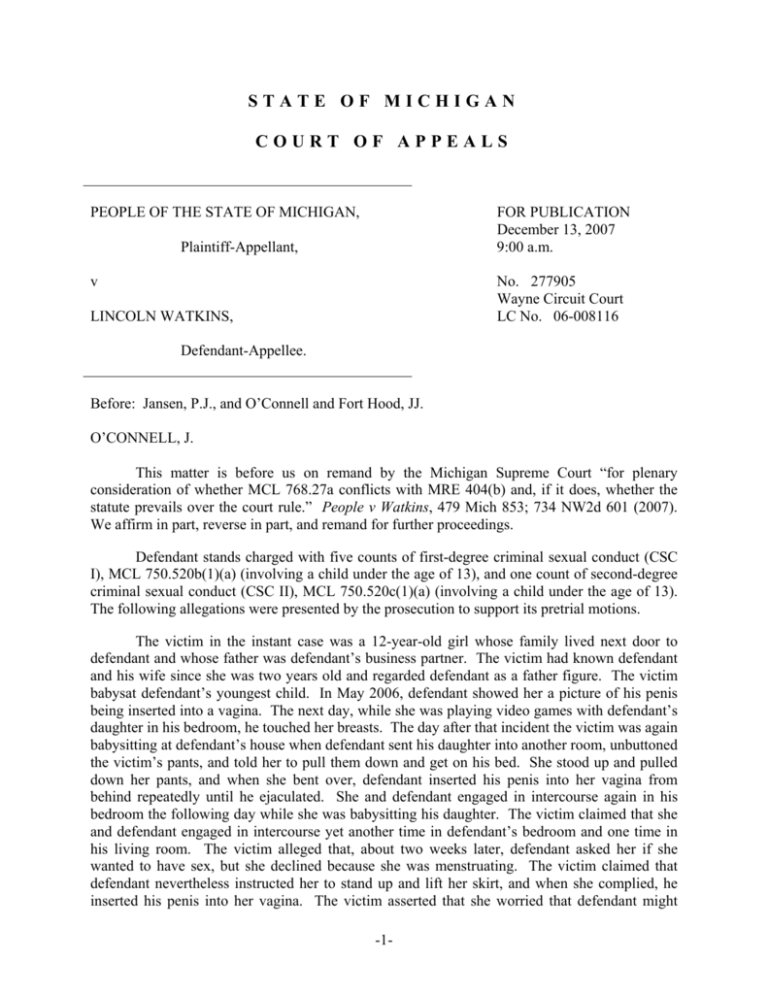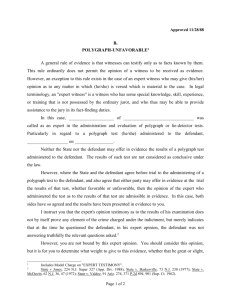
STATE OF MICHIGAN
COURT OF APPEALS
PEOPLE OF THE STATE OF MICHIGAN,
FOR PUBLICATION
December 13, 2007
9:00 a.m.
Plaintiff-Appellant,
v
No. 277905
Wayne Circuit Court
LC No. 06-008116
LINCOLN WATKINS,
Defendant-Appellee.
Before: Jansen, P.J., and O’Connell and Fort Hood, JJ.
O’CONNELL, J.
This matter is before us on remand by the Michigan Supreme Court “for plenary
consideration of whether MCL 768.27a conflicts with MRE 404(b) and, if it does, whether the
statute prevails over the court rule.” People v Watkins, 479 Mich 853; 734 NW2d 601 (2007).
We affirm in part, reverse in part, and remand for further proceedings.
Defendant stands charged with five counts of first-degree criminal sexual conduct (CSC
I), MCL 750.520b(1)(a) (involving a child under the age of 13), and one count of second-degree
criminal sexual conduct (CSC II), MCL 750.520c(1)(a) (involving a child under the age of 13).
The following allegations were presented by the prosecution to support its pretrial motions.
The victim in the instant case was a 12-year-old girl whose family lived next door to
defendant and whose father was defendant’s business partner. The victim had known defendant
and his wife since she was two years old and regarded defendant as a father figure. The victim
babysat defendant’s youngest child. In May 2006, defendant showed her a picture of his penis
being inserted into a vagina. The next day, while she was playing video games with defendant’s
daughter in his bedroom, he touched her breasts. The day after that incident the victim was again
babysitting at defendant’s house when defendant sent his daughter into another room, unbuttoned
the victim’s pants, and told her to pull them down and get on his bed. She stood up and pulled
down her pants, and when she bent over, defendant inserted his penis into her vagina from
behind repeatedly until he ejaculated. She and defendant engaged in intercourse again in his
bedroom the following day while she was babysitting his daughter. The victim claimed that she
and defendant engaged in intercourse yet another time in defendant’s bedroom and one time in
his living room. The victim alleged that, about two weeks later, defendant asked her if she
wanted to have sex, but she declined because she was menstruating. The victim claimed that
defendant nevertheless instructed her to stand up and lift her skirt, and when she complied, he
inserted his penis into her vagina. The victim asserted that she worried that defendant might
-1-
force her to have sexual intercourse in the future, so she told her mother that she had been having
a sexual relationship with defendant.
Before defendant’s first trial, which resulted in a mistrial, the trial court granted the
prosecution’s motion to admit evidence of similar acts through the testimony of Ekemini
Williams and Kesha Hobley. At the first trial, Williams testified that defendant’s wife is her first
cousin and she met defendant when she was 14 years old. Williams loved defendant like a
brother and often babysat for defendant’s children. On one occasion when she was 15 years old,
she visited defendant and his wife for the weekend and helped them with their infant. While
alone with Williams, defendant commented on her sexual attractiveness, took her hand, and
began leading her up the stairs to his bedroom on the second floor. Williams was reluctant to go
upstairs, so defendant pulled down her pants and inserted his penis into her vagina while they
were still in the hallway. After eventually moving to defendant’s bedroom, they continued
having intercourse until defendant ejaculated. Williams stated that the episode began a two-year
sexual relationship, during which they had sexual encounters about 15 different times at
defendant’s home, her mother’s home, and in empty houses where defendant was painting.
Williams explained that defendant included her in his family; they went to an amusement park
together, went out to eat together, and watched movies together.
Hobley, who is also a first cousin of defendant’s wife, testified at the first trial as well.
Hobley met defendant when she was 16 years old. Hobley moved in with defendant and his wife
in 1998 when Hobley was 20 years old, and she lived with them for six or seven months. Hobley
recalled that defendant sexually assaulted her several times during this period, and that he
attempted to sexually assault her again in 2003.
On May 9, 2007, before the second trial began, the trial court granted defendant’s motion
for reconsideration and ruled that Hobley’s testimony was not admissible because Hobley was a
grown woman at the time of her nonconsensual sexual activity with defendant. The court further
held that Williams’s testimony was too different from the victim’s description of the charged acts
to justify the use of Williams’s testimony to prove a common plan or scheme. Therefore, the
court held that neither the court rules nor the recently enacted statute, MCL 768.27a, permitted
the prosecutor to introduce the evidence in defendant’s second trial.
On May 14, 2007, this Court issued an order that peremptorily reversed the trial court’s
order regarding Williams’s testimony, but it affirmed the trial court’s exclusion of Hobley’s
testimony. This Court’s order remanded the case to the trial court and ordered it to determine
which aspects of Williams’s proposed testimony pertained to the commission of listed offenses
under MCL 768.27a while Williams was a minor. Our Supreme Court vacated this Court’s order
and remanded the case to this Court “for plenary consideration of whether MCL 768.27a
conflicts with MRE 404(b) and, if it does, whether the statute prevails over the court rule.”
Watkins, supra at 853.
The prosecution argues that the evidence regarding Williams and Hobley is admissible
because there is a conflict between MCL 768.27a and MRE 404(b), and MCL 768.27a controls.
Under the circumstances of this case, we agree. The decision whether to admit evidence will not
be disturbed on appeal absent an abuse of discretion. People v Katt, 468 Mich 272, 278; 662
NW2d 12 (2003). However, when the decision whether to admit evidence involves a
-2-
preliminary question of law, as it does here, we review the legal issue de novo. Id.; People v
Kimble, 470 Mich 305, 308-309; 684 NW2d 669 (2004).
MCL 768.27a(1) provides:
[I]n a criminal case in which the defendant is accused of committing a listed
offense against a minor, evidence that the defendant committed another listed
offense against a minor is admissible and may be considered for its bearing on
any matter to which it is relevant. If the prosecuting attorney intends to offer
evidence under this section, the prosecuting attorney shall disclose the evidence to
the defendant at least 15 days before the scheduled date of trial or at a later time
as allowed by the court for good cause shown, including the statements of
witnesses or a summary of the substance of any testimony that is expected to be
offered.
MRE 404(b)(1) provides:
Evidence of other crimes, wrongs, or acts is not admissible to prove the character
of a person in order to show action in conformity therewith. It may, however, be
admissible for other purposes, such as proof of motive, opportunity, intent,
preparation, scheme, plan, or system in doing an act, knowledge, identity, or
absence of mistake or accident when the same is material, whether such other
crimes, wrongs, or acts are contemporaneous with, or prior or subsequent to the
conduct at issue in the case.
Our Supreme Court has exclusive rulemaking authority with respect to matters of practice
and procedure for the administration of our state’s courts. Const 1963, art 6, § 5; People v
Pattison, ___ Mich App ___; ___ NW2d ___ (Docket No. 276699, issued September 11, 2007),
slip op at 3. Generally, if a court rule conflicts with a statute, the court rule governs when the
matter pertains to practice and procedure. People v McGuffey, 251 Mich App 155, 165; 649
NW2d 801 (2002). However, to the extent that the statute, as applied, addresses an issue of
substantive law, the statute prevails. Id. This Court recently held that “MCL 768.27a is a
substantive rule of evidence because it does not principally regulate the operation or
administration of the courts.” Pattison, supra at 3.
MCL 768.27a allows evidence of other listed offenses to be admitted and “considered for
its bearing on any matter to which it is relevant.” Defendant is charged with CSC I, MCL
750.520b, and CSC II, MCL 750.520c, which are listed offenses. MCL 28.722(e)(x). At least
some of the conduct described by Williams constitutes, at a minimum, third-degree criminal
sexual conduct, MCL 750.520d(1)(a) (involving a child of at least 13 but less than 16 years of
age). However, MRE 404(b)(1) dictates that evidence of other acts “is not admissible to prove
the character of a person in order to show action in conformity therewith.” Instead, other acts
evidence is only admissible “for other purposes, such as proof of motive, opportunity, intent,
preparation, scheme, plan, or system in doing an act, knowledge, identity, or absence of mistake
or accident when the same is material . . . .” MRE 404(b). As this Court noted in Pattison,
supra at 3:
-3-
MCL 768.27a allows prosecutors to introduce evidence of a defendant's
uncharged sexual offenses against minors without having to justify their
admissibility under MRE 404(b). In many cases, it allows evidence that would
have previously been inadmissible, because it allows what may have been
categorized as propensity evidence to be admitted in this limited context.
Contrary to defendant’s argument in the trial court, there is no real question that Williams’s
testimony, if believed, tends to increase the probability that defendant committed the charged
offenses. MRE 401. Therefore, the evidence is plainly relevant for purposes of MCL 768.27a,
and nothing indicates that it was a primary consideration in the trial court. Instead, the trial court
found that Williams’s testimony about her sexual experiences with defendant was not similar
enough to admit them as evidence of a common plan or scheme under MRE 404(b). However,
similarity is simply an inapposite consideration under MCL 768.27a. Therefore, there is a
conflict in this case between the statute and the court rule, because the trial court ruled, within its
discretion, that MRE 404(b) required the exclusion of the evidence, while MCL 768.27a plainly
allows the prosecutor to present at least some of the testimony to the jury.
We make determinations about whether court rules conflict with statutes on a case-bycase basis, recognizing that the Legislature has preeminence over substantive issues. McDougall
v Schanz, 461 Mich 15, 36-37; 597 NW2d 148 (1999). The conflict here centers on the
Legislature’s substantive policy decision that in these cases “juries should have the opportunity
to weigh a defendant’s behavioral history and view the case’s facts in the larger context that the
defendant’s background affords.” Id. Because MCL 768.27a is a substantive rule of evidence
deeply rooted in weighty policy considerations, it controls this issue. McGuffey, supra.
Consequently, we remand for a determination of which aspects of Williams’s testimony related
to the commission of listed offenses under MCL 768.27a. Those aspects of Williams’s
testimony are admissible. Hobley’s testimony does not describe a listed offense against a minor,
so MCL 768.27a simply does not apply, and we do not disturb the trial court’s decision to
exclude Hobley’s testimony.
Affirmed in part, reversed in part, and remanded for further proceedings consistent with
this opinion. We do not retain jurisdiction.
/s/ Peter D. O’Connell
/s/ Kathleen Jansen
/s/ Karen M. Fort Hood
-4-









